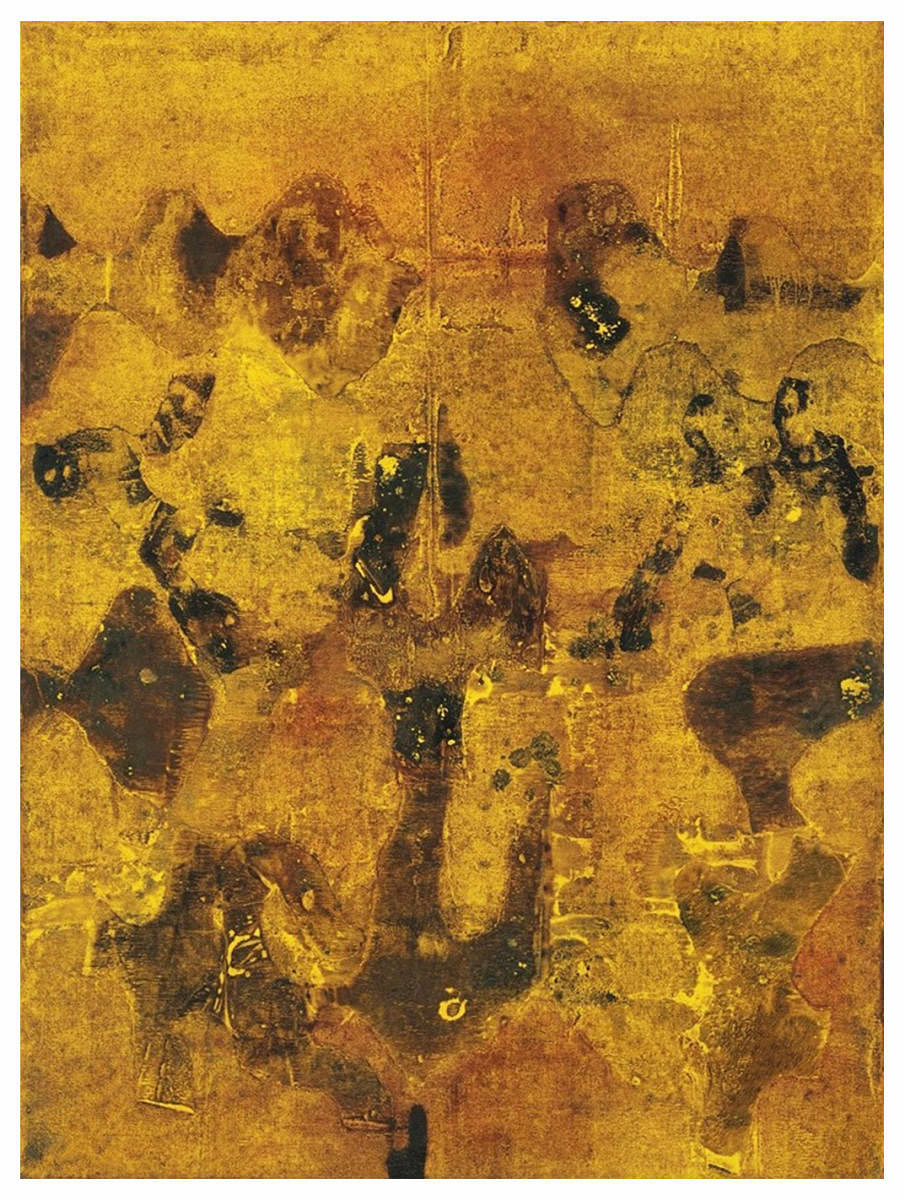
When Gaitonde wants to say something about his canvases, he merely keeps quiet,” wrote journalist and literary critic Sham Lal. “With his love for Zen, which is written into each one of his canvases, he knows that the meaning of a work of art can be sensed only in the depths of silence.”
Through intense practice and meticulous understanding of lines, planes, textures and mystical colours, Vasudeo S Gaitonde (1924–2001) brought a poetic reflection and meditative vision to his art. His images held a unique tonal quality and luminous depth revealing a deep appreciation of space and spatial relationships. The artist described his work to be ‘a play of light and colour’ and not a physical representation of an object or a landscape. He also saw a continuum in his work with every painting holding the seed, which would germinate in the next. “A painting is not limited to one canvas, I go on adding elements and that’s how my work evolves... There is a kind of metamorphosis in every canvas and the metamorphosis never ends.”
Gaitonde, according to several critics, was India’s greatest abstract master whose art looked like a painted prayer. He was among the handful painters of his generation who did not return to figural painting. He enjoyed a slow and a meticulous painting process, often employing a roller rather than a paintbrush. Among his major influences were Japanese Zen philosophy, Hindu spirituality, Jain and Mughal miniatures and ancient calligraphy. The power of classical music held a sway on him as much as colour field techniques of painters such as Mark Rothko, Paul Klee and Hans Hofmann. The sea too was a source of perennial inspiration to the artist who in the 1960s would sit on a bench and stare at the simmering waters for hours. “In Gaitonde’s work, the theme of the sea, the surf, the play of light, and the sea’s mystique itself are orchestrated as music heard within the mind and expressed as a score or an organic fabric, a fine lace-work of melodic motifs,” wrote art critic Richard Bartholomew in 1982.
However, it was silence that seemed to matter most to the non-conformist and ascetic artist. “Everything starts from silence,” he explained. “The silence of the brush, the silence of the canvas, the silence of the painting knife. The painter starts by absorbing all these silences... No one part of you is working there. Your entire being is.”
Reclusive and quiet
Gaitonde was known to immerse himself not only in a deeply personal creation of art, but also in contemplating the codes, patterns and mysteries of the natural world. Bartholomew described him as “a quiet man and a painter of the quiet reaches of the imagination.” A bachelor all his life, Gaitonde lived in a single-room flat in Delhi until a few years before his death in 2001. In the 1980s, when he was unable to paint on large canvases (after being knocked over by a rickshaw), he worked on smaller images incorporating minimalist, but meaningful symbols and calligraphy.
Unlike his more prolific contemporaries, Gaitonde produced very few finished works during his lifetime. According to one estimate, the meditative artist who explored the labyrinths of inner spaces and transient realities, produced no more than five to six canvases in a year. “I don’t work. I relax. I wait and then apply colours.” He also believed that a painting always existed within the artist; and one had to just make oneself the perfect machine to express what is already there. Gaitonde would supposedly destroy his paintings if they did not meet his exacting standards. He felt that an artist should allow his work to evolve, while being in full control of the flow. “Like music, I know when it is at an end.”
Born in Nagpur, Maharashtra, to Goan parents, Gaitonde received his diploma from the J J School of Art, Bombay, in 1948. He was part of the Progressive Artists Group spearheaded by fellow-Goan painter Francis Newton Souza. According to writer-photographer Vivek Menezes, ‘the dynamic duo of Indian art’ — Souza and Gaitonde, spoke to each other in Konkani at all times. “It is true that both men were archetypical Goan artistic geniuses in the fact that both of them were supremely confident about their own artistic worth even if their own people remained ignorant to it,” writes Menezes. “Souza and Gaitonde died relatively alone, without much money to show for their spectacular careers, but neither had any regrets about those circumstances.”
A life after death
Gaitonde’s unique standing in Indian art won him many admirers (and a Padma Shri in 1971). For one who did not care about what was fashionable or marketable during his lifetime, Gaitonde’s reputation skyrocketed posthumously. Among the several prestigious institutions to hold his retrospective exhibitions was one hosted in 2014-15 by the Guggenheim in New York titled Painting as Process, Painting as Life. Writing on the exhibition, the New York Times art critic Holland Cotter described Gaitonde as ‘a 20th-century Indian modernist who looked westward, eastward, homeward and inward to create an intensely personalised version of transculturalism, one that has given him mythic stature in his own country and pushed him to the top of the auction charts.’
Gaitonde, undoubtedly, has become a darling of art collectors. In February 2005, one of his 1972 paintings sold for a record bid of Rs 92 lakh. In March 2010, his ‘Blue Abstract’ (1965) went for $554,500 at Christie’s New York auction. In 2013, at the inaugural Christie’s auction in India, Untitled (1979) sold for Rs 23 crore ($3.8 million), making it the most expensive painting ever by an Indian artist as on that date. Two years later, Untitled (1995), fetched Rs 29 crore. Very recently, on 11 March 2021, his 50 x 80-inch horizontal canvas (1961) sold for Rs 39.98 crore at Saffronart. It the highest price an Indian artwork has ever fetched at an auction across the world.